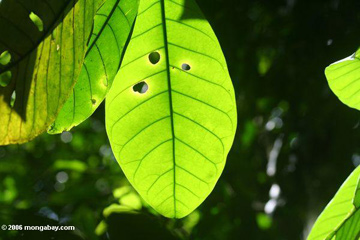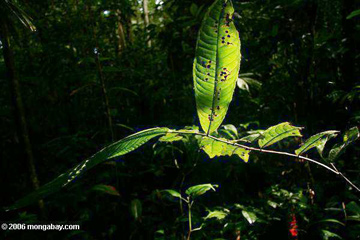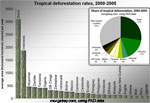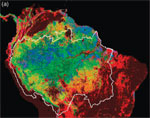Forest carbon may not fully offset fossil carbon, says expert
Forest carbon does not fully offset fossil carbon
mongabay.com
December 3, 2007
As policymakers meet in Bali, Indonesia to discuss various mechanisms for mitigating greenhouse emissions, a tropical ecologist from Sri Lanka warns that one ton of forest carbon is not equal to one ton of fossil carbon when it comes to using offsets to fight global warming. The implications: considerably larger forest areas (preferably old growth since it has higher carbon values than plantations) would need to be protected and reforested than are presently anticipated by most policymakers.
Dr. Ranil Senanayake, chairman of Rainforest Rescue International, says that fossil carbon, which has been locked up for tens of millions of years, cannot be treated the same as carbon from biotic sources, which is ephemeral by comparison, lasting at most a few tens of thousand of years. Factor in the potential impact of climate change on forest biomass and the likelihood of deforestation or forest fires, and there are few guarantees that carbon presently sequestered in a forest will stay that way. Further, most carbon offset schemes fail to account for differences in longevity of carbon stored in different types of vegetation.
“The longer any material stores sequestered carbon, the more valuable it is to the initiatives that sequester carbon to reduce the atmospheric concentration,” Dr. Senanayake told mongabay.com. “Consequently, time must be accepted as a value variable when trading in sequestered carbon. Within the biological system, carbon is taken up in many ways though photosynthesis or carbonate cycles with each having internal processes that operates at different rates. For instance, the photosynthetic activity of plants takes carbon dioxide out of the atmosphere and fixes it as a solid state in organic matter creating biomass. While all plants sequester carbon, trees and woody plants are most efficient in producing resistant compounds such as lignin.”
 Old growth tropical rainforest stores more carbon than the plantations that often replace it. Rainforest in Uganda |
“The sequestering value of wood is in its durability, its capacity to withstand the attacks of decay organisms,” he continued. “Archeological finds often demonstrate wooden artifacts dating back about 1000 years. In America, a durability standard has been devised by using White Oak as the standard. In this method of evaluation White Oak is given a rating of (100). Wood with higher scores such as Red Cedar (150-200) or Black Locust (150-250) is more durable. Woods with a lower score such as Hemlock (35-55) or Birch (35-50) are less durable.”
A second key point, says Dr. Senanayake, is that “the origin and state of all carbon compounds differ in terms of the contribution to climate change.”
“The second problem in the evaluation of carbon can be traced to the work of some modern modelers. They missed or ignored a crucial element in evaluating the dynamics of the carbon cycle discussed above in terms of sources and sinks. Sources are those carbon compounds that decay into carbon dioxide and sinks are carbon compounds made from carbon dioxide,” explained Dr. Senanayake.
“This represents a fundamental flaw in the current model. In evaluating relative values of carbon sinks, the source of carbon is critically important. What differentiates the setting value of carbon dioxide is the cycling time of the source of carbon and the retention time of the sink. In this respect, there are two major cycling systems to be considered as carbon sources, the biological and geological,” he continued.
“In our rush to create the new carbon economy, this very simple and fundamental fact has been ignored. Carbon that cycles through living systems represents a fixed proportion of the planetary carbon. The planetary carbon is the total found in mineral, organic and inorganic carbon.”
 Between 2000 and 2005, the planet lost 6 million hectares of primary forests per year. Rainforest in Colombia. |
“The carbon that enters the biotic cycle has, in most cases, been a product of photosynthetic activity. In geologic time, carbon is added to the atmosphere through tectonic processes. In an attempt to remove this excess carbon dioxide from the biosphere a small proportion is fossilized and enters the lithosphere never to interact with the biosphere again. This small proportion is translated into vast quantities of fossilized carbon and removed from the biotic/atmospheric cycles. These fossil pools have lifetimes of tens or hundreds of millions of years.”
“Thus the value differential produced by these cycles, the biotic and the fossil, must be recognized. The biotic carbon operates on time frames of tens or hundreds of thousands of years. The fossil carbon in tens or hundreds of millions years. Further fossil carbon is not interactive with the living or biotic cycle. Fossil carbon entering the biotic cycle is the fundamental reason as to why there is the accelerating greenhouse effect. the growing of trees to compensate for fossil carbon and paying the same price as biotic carbon is tantamount to ‘carbon laundering’. There is no way to compare the carbon from oil and coal with the carbon from a forest. One has a space in the biotic cycle the other does not.”
“My concern is that if we allow the laundering of fossil carbon at a mere $10-$15/ton we will not make any change in the resources for response as well as on reducing the impact. If the sequestration value of biotic carbon is $10.00/ton (considering a 100,000 year residence time for any given time pool) the corresponding value of fossil carbon must be $1000/ton at a minimum. To liquidate either must entail a cost equivalent to its value and the price paid for sequestration must reflect this. If we get this discussion into the global bureaucratic agenda, we could make a real change, by empowering the work that we both agree on.”
“I have been attempting to get the different carbon pools recognized by the international system for over ten years, but the oil industry and the ‘forestry’ industry have been blocking it. The attached paper might be of use. If you need a short clear article (or an interview) I will be happy to do so. The logical conclusion to accepting this reality is that the fossil industry will have to pay over $1000- $400.00 ton to get their carbon fixed. Think about it, the carbon in the biotic pool is sequestered for 100,000 years max. So if we are raying $10.00 per ton to fix biotic carbon generated as a result of liquidating the asset (forest clearing, agricultural conversion), Thus if we look at the fossil pool that is sequestered for times exceeding 10-100 million years. The liquidation of this stock and its sequestering must cost at least $1000 a ton.”
Carbon Laundering
Dr. Senanayake says that the current system, which treats forest carbon the same as fossil carbon, is akin to “carbon laundering.”
“Allowing carbon from fossil sources to gain the same value as biotic carbon by cycling it through a tree is nothing short of ‘Carbon Laundering’ very much the same as money laundering. Residence times for biotic carbon is measured in hundreds of thousands of years, while fossil carbon is measured in times of tens of millions years. To make matters worse the perverse system adopted today does not recognize time as a value variable. The concept of ‘incremented carbon’ does not value the time that carbon is sequestered for, only the carbon sequestered through human interventions is. Thus it is profitable to cut down an old growth forest and replace it with a quick growing plantation.”
Rainforest Rescue International
Related articles
Could the carbon market save the Amazon rainforest?
(11/29/2007) The global carbon market could play a key role in saving the Amazon from the effects of climate change and economic development, which could otherwise trigger dramatic ecological changes, reports a new paper published in Science. The authors argue that a well-articulated plan, financed by carbon markets, could prevent the worst outcomes for the Amazon forest while generating economic benefits for the region’s inhabitants.
Carbon credits for forest conservation concept faces challenges
(11/27/2007) While environmentalists, scientists, development exports, and policymakers across the political spectrum are ethusiastic about the idea of offsetting carbon emissions by preventing deforestation (a concept known as “avoided deforestation” or Reduced Emissions from Deforestation and Degradation (REDD)), the concept still faces many challenges, especially in implementation.
Carbon offset returns beat forest conversion for agriculture in Indonesia
(11/21/2007) Conversion of forests and peatlands for agriculture in Indonesia has generated little economic benefit while releasing substantial amounts of greenhouse gases into the atmosphere, reports a new study from the the World Agroforestry Centre (ICRAF), the Center for International Forestry Research (CIFOR) and their Indonesian partners.
Carbon-negative bioenergy to cut global warming could drive deforestation
(11/6/2007) A proposed mechanism for generating carbon-negative bioenergy — an energy source that reduces atmospheric carbon dioxide levels — could drive large-scale deforestation in the tropics and undermine efforts to conserve forests for carbon offsets says a biofuel expert.
Is the Amazon more valuable for carbon offsets than cattle or soy?
(10/17/2007) After a steep drop in deforestation rates since 2004, widespread fires in the Brazilian Amazon (September and October 2007) suggest that forest clearing may increase this year. All told, since 2000 Brazil has lost more than 60,000 square miles (150,000 square kilometers) of rainforest — an area larger than the state of Georgia or the country of Bangladesh. Most of this destruction has been driven by clearing for cattle pasture and agriculture, often in association with infrastructure development and improvements. Higher commodity prices, especially for beef and soy, have further spurred forest conversion in the region. While drivers of Amazon deforestation are stronger than ever, mounting concerns over climate change and the effort to reign in greenhouse gas emissions may provide new economic incentives for landowners to preserve forest lands through a concept known as “avoided deforestation”.
Missing carbon is in the tropics, not temperature forests
(6/21/2007) Temperate forests are doing less than expected to offset climate change, while tropical forests are absorbing an unexpectedly high proportion of carbon dioxide from the atmosphere, reports a study published this week in the journal Science. The findings have implications for offset programs and climate policy.
 |
Reducing tropical deforestation will help fight global warming
(5/10/2007) Scientists have lent support to a plan by developing countries to fight global warming by reducing deforestation rates. Tropical deforestation releases more than 1.5 billion metric tons of carbon into the atmosphere every year, though in some years, like the 1997-1998 el Nino year when fires released some 2 billion tons of carbon from peat swamps alone in Indonesia, emissions are more than twice that. Writing in the journal Science, an international team of scientists argue that the Reducing Emissions from Deforestation (RED) initiative, launched in 2005 by the United Nations Framework Convention on Climate Change, is scientifically and technologically sound, and that political and economic challenges facing the plan can be overcome.
 |
Amazon rainforest locks up 11 years of CO2 emissions
(5/8/2007) The amount and distribution of above ground biomass (or the amount of carbon contained in vegetation) in the Amazon basin is largely unknown, making it difficult to estimate how much carbon dioxide is produced through deforestation and how much is sequestered through forest regrowth. To address this uncertainty, a team of scientists from Caltech, the Woods Hole Institute, and INPE (Brazil’s space agency), have developed a new method to determine forest biomass using remote sensing and field plot measurements. The researchers say the work will help them better understand the role of Amazon rainforest in global climate change.